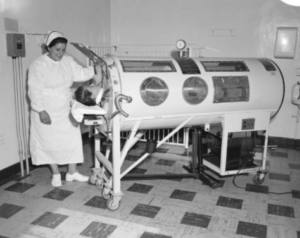Paul Alexander, one of two people in the United States relying on an iron lung, died recently at 78 years old. Paul contracted polio in 1952 at six years old, and has had to rely on an iron lung — a big metal ventilator that encases the body from the neck to toes — since then. Radio Diaries was lucky enough to speak to Paul a few years before he died, about his life living under uncommon circumstances, and the lessons he’s learned from it. So, this podcast, we’re revisiting the story of Martha Lillard, with some life advice from Paul Alexander.

Paul refused to let his circumstances stop his goals: he managed to graduate law school, practice law, and even write a book. He would use a stick in his mouth to type, or turn the pages of his schoolbooks.
“I’ve been able to accomplish anything I’ve set out to do,” Paul said. “Everyone said, ‘You can’t do that.’ And then I turn around and do it. That’s a part of being alive and continuing on with my dreams and goals.”
Paul even had a TikTok account of over 400,000 followers, where he doled out advice and answered questions about the iron lung — from how he stayed motivated, to how he goes to the bathroom.
“I’ve been able to accomplish anything I’ve set out to do,” Paul said. “Everyone said, ‘You can’t do that.’ And then I turn around and do it. That’s a part of being alive and continuing on with my dreams and goals.”
After Paul’s passing, Martha Lillard is now the last person in the U.S. relying on an iron lung to survive.
Lillard contracted polio at five years old, in 1953. She spent six months in the hospital, where she was put in a ventilator called an iron lung to help her breathe. To this day, Martha is one of only two people in the United States who still depends on the iron lung to survive. On this episode of Radio Diaries, we share her story.

A nurse attends to a boy in an iron lung.
In the first half of the 20th century, the disease known as poliomyelitis panicked Americans. Just like Covid today, polio stopped ordinary life in its tracks. Tens of thousands were paralyzed when the virus attacked their nervous systems. Many were left unable to walk. In the worst cases, people’s breathing muscles stopped working, and they were placed in an iron lung, a giant ventilator that fits the human body from the neck down.
Patients lie inside with just their heads resting outside; a seal around the patient’s neck creates a vacuum. Bellows at the base of the device do the work of a human diaphragm — they create negative pressure so the user’s lungs fill with air, and positive pressure allowing them to exhale.
A polio vaccine became widely available in 1955 — and millions of Americans got vaccinated. The iron lung became obsolete and they stopped being manufactured in the late 1960’s. While many people who suffered from polio or post-polio syndrome either weaned themselves off the machines or switched to another form of ventilator, Martha never did.

Martha Lillard in 2016.
Her biggest challenge is maintenance. The iron lung needs parts switched every few months and no one makes them anymore. When her machine started breaking down in the 1990’s she had to find a replacement. She went to hospitals and museums, but they’d either thrown them away or didn’t want to part with what was in their collection. She finally found one from a man in Utah.
Martha has even gotten trapped in the iron lung. She lost power when an ice storm came through Oklahoma and the generator she has in case of emergencies didn’t kick on. She was stuck in the iron lung, lying in the cold, “it’s like being buried alive almost, you know, it’s so scary,” Martha says. She tried to call 911, but the cell towers weren’t working. She recalls, “I was having trouble breathing. And I remember saying out loud to myself, I’m not going to die.” Eventually she was able to get a signal, Martha remembers the emergency responders had never seen an iron lung before and didn’t know what it was, but they were able to get the generator going for her.
She’s tried other ventilators, but for Martha, the iron lung is the most comfortable and most efficient way to breath. She sleeps it in every night. Sixty-seven years after contracting polio, an iron lung is still keeping Martha alive.
A full transcript of this episode is available here.
Film from National Archives, Papers of Drew Pearson, 1915 – 1969








